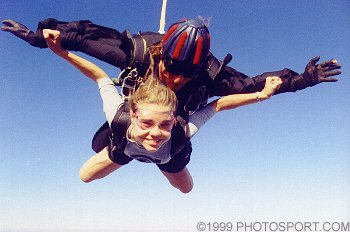
|
Drag When Joe jumps
from the airplane, both gravity and air resistance (a type of frictional
force) immediately begin to act on his mass. While gravity remains
constant, air resistance does not. Air resistance will increase
as Joe's earthbound velocity also increases.
The force of the air particles colliding into Joe's body can be
altered even further. Joe can change the shape of his body, increasing: The amount of drag (resistant) force exerted on Joe's body can be represented by the following equation: R = .5 * D* p * A * v^2 Where D is the
drag coefficient, p is the density of the medium, in this case air,
A is the cross-sectional area of the object, and v is velocity of
the object. As you can see, if velocity or cross-sectional area
is increased, the drag force will also increase. Eventually the
drag force acting on Joe will equal the force of gravity. At this
point Joe will have a net force of 0 N acting on him, thus he has
reached his terminal (max) velocity
(which is discussed on another page on this site).

(http://wings.avkids.com/Book/Sports/Images/parachute.gif) As you can see, the cross-sectional area of the parachute is much greater than that of Joe. Also note the top vent on the parachute. This is prevents the shoot from crumpling up and folding upwards, as air attempts to flow via means of least resistance. Since an increase in cross-sectional area also causes a decrease in Joe's velocity, eventually the forces will equilibrate, and Joe will cease to accelerate. When this finally occurs, Joe's rate of speed should be relatively low, allowing him to land safely on the earth. Here is a full summary of the change in force of the process:
|



